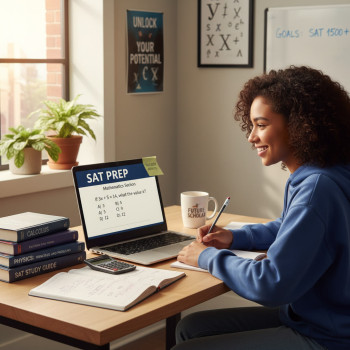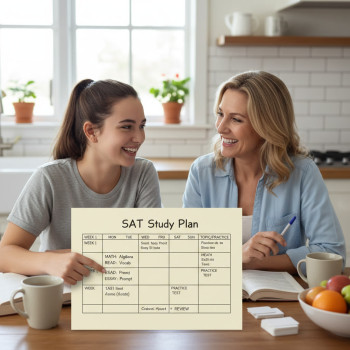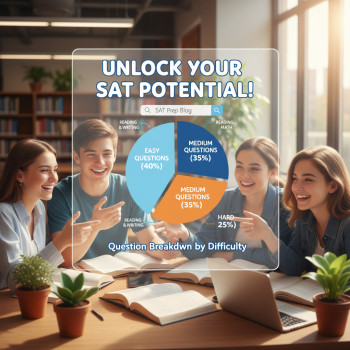Introduction: Why myths about the SAT are more harmful than helpful
If you’ve spent any time in the whirlwind of college prep, you’ve probably heard a dozen rules about the SAT that sound like law: “Never guess,” “You need to study 6 hours a day,” “The SAT is only about memorizing tricks.” Some of these ideas used to have a grain of truth; others are pure rumor. Now that the SAT is fully digital, some old myths have gotten a second wind while new ones have cropped up. The problem with myths is they steal your time, zap your confidence, and send you in the wrong direction.
Let’s clear the air. This post will debunk the most persistent SAT myths, explain what actually matters for score gains, and give practical, realistic steps you can take next. I’ll also show where targeted supports like Sparkl’s personalized tutoring — with 1-on-1 guidance, tailored study plans, expert tutors, and AI-driven insights — can fit naturally into your plan when you want an efficient boost.
Myth 1: You must study for months every day to improve your score
The image of a student chained to a desk cramming every night is dramatic, but misleading. Study time matters, yes — but how you use that time matters more.
Quality beats quantity. Focused, active practice (targeted drills, full-length adaptive practice tests on the Bluebook app, and focused review of mistakes) will get you farther than dispersing your attention across unfocused hours of passive reading.
Practical alternative
- Set a sustainable schedule: 3–5 focused sessions per week of 60–90 minutes each beats nine distracted hours.
- Make each session purposeful: pick one skill (e.g., algebraic reasoning, command of evidence) and practice deliberately.
- Use adaptive practice tests to replicate test conditions and the digital interface.
Myth 2: The digital SAT is just about being good with technology
It’s true the test is delivered digitally, and you’ll use the Bluebook testing app on an approved device — but the skills measured are the same: reading comprehension, writing and language, and math reasoning. Being comfortable with the interface helps (know the tools for highlighting, flagging, and navigation), but you won’t pass the test by being a fast typist or a tech whiz alone.
Practical alternative
- Practice on the actual testing app or official digital practice tests to become familiar with navigation and tools.
- Focus study time on content and strategy; simulate the test digitally so interface skills don’t surprise you on test day.
Myth 3: You can’t improve much after a certain point — your score is fixed
People like tidy narratives: “You’re either good at standardized tests or you’re not.” It’s comforting, but wrong. Scores are the result of skills and strategies that can be developed. Many students see big jumps when they learn to analyze mistakes, manage time, and target weak areas.
Why improvement is real
- The test measures discrete skills (like algebraic manipulation or evidence-based reading). You can practice and improve those skills.
- Strategy changes — such as educated guessing, passage-skimming techniques, and time allocation — can unlock hidden points.
- Official digital practice tests are adaptive, allowing you to see where your skill pattern is strong and where it’s not.
Myth 4: Memorizing vocabulary or formulas is the secret
Memorization helps in small, specific ways, but the SAT rewards reasoning more than recall. For example, knowing some high-frequency vocabulary is useful, but understanding context clues and how writers build arguments is far more powerful. Similarly, memorize essential math formulas, but prioritize conceptual understanding and the steps you’ll use to apply them under time pressure.
What to do instead
- Practice applying formulas in several contexts, not just memorizing them.
- Do active reading exercises that focus on identifying a passage’s main idea, structure, and evidence.
- Work backward from correct answers to see why other choices are wrong.
Myth 5: Practice tests are only for endurance — they don’t teach you much
Practice tests are among the most valuable tools — when used correctly. They’re not just for building stamina; they’re diagnostic. The single most useful thing you can do after a practice test is a focused error analysis.
How to use practice tests well
- Take full-length digital practice tests under realistic conditions occasionally to check progress.
- After each test, spend as much time reviewing mistakes as you did taking it. Classify errors: careless, content gap, timing, or strategy.
- Create short, targeted practice routines (20–40 minutes) to address a common error type.
Myth 6: Guessing is always bad
That old advice to never guess came from eras with different scoring rules. Today, guessing smartly is part of test strategy. If you can eliminate one or more answer choices, it’s usually worth selecting the most likely remaining option. Don’t leave blanks unless you absolutely can’t make an educated choice.
Smart guessing checklist
- Eliminate clearly wrong answers first.
- If you can eliminate at least one answer, make a guess — your odds have improved.
- Use timing strategies so you have time for educated guesses on tougher questions.
Myth 7: High scores are only for students who took every AP/IB course
Coursework matters for college readiness, but SAT success is not strictly tied to taking a particular set of classes. Students from a wide range of academic backgrounds score highly when they develop test skills and prioritize targeted practice. Admissions look at a holistic record: grades, coursework, activities, essays, and test scores together.
What actually helps
- Master core skills — algebra, geometry, evidence-based reading — through classwork and extra practice.
- Add practice that mirrors the test: timed passages, math problems that require reasoning, and mixed-topic drills.
- Consider targeted tutoring when you need to bridge a specific content gap or sharpen test strategies.
Myth 8: The only way to improve is to study alone
Independent study works for some, but most students benefit from feedback. A teacher, coach, or a good 1-on-1 tutor can spot recurring mistakes you miss, provide accountability, and teach efficient strategies. Personalized help becomes even more valuable when time is limited.
Sparkl’s personalized tutoring — where tutors create tailored study plans, provide one-on-one guidance, and leverage AI-driven insights to target weaknesses — is a natural fit if you want concentrated improvement and a coach who learns how you learn.
Myth 9: The test rewards speed over accuracy
Speed matters because there’s a time limit, but accuracy is king. Rushing through questions increases careless errors and often reduces score. The digital SAT’s structure rewards steady pacing and smart time management: know when to invest extra time in a promising question and when to move on and return if time allows.
Balanced timing strategy
- Allocate time per passage or problem before you begin and stick loosely to it.
- Use flagging tools to mark questions to revisit.
- Train with timed, adaptive practice to build efficient pacing without panic.
Myth 10: Test day logistics are minor — just show up
Test logistics — device readiness, software familiarity, testing supplies, and test-day routines — matter more in the digital era. Technical hiccups or unfamiliarity with the testing app add stress that affects performance.
Test-day checklist
- Install and test the Bluebook app or do a test preview well before test day.
- Confirm your device meets approved-device requirements and has necessary updates.
- Bring necessary ID, backup charger if permitted, approved scratch paper and pencils, and a calm, practiced routine for the morning.
Quick comparison: Old myths vs. modern test realities
| Myth (Old belief) | Modern reality |
|---|---|
| More hours = guarantee of improvement | Focused, deliberate practice and targeted review produce faster, more reliable gains |
| Memorize vocabulary to ace reading | Contextual reasoning and evidence analysis are more valuable than rote vocab lists |
| Digital SAT favors tech-savvy students | Content and strategy matter most; interface familiarity reduces friction |
| Guessing is always penalized | Smart guessing is often beneficial; eliminate wrong answers first |
How to build a myth-busting study plan that actually works
After you’ve let go of the myths, structure a plan that emphasizes measurable progress. Here’s a practical, flexible plan that many students find effective in 8–12 weeks:
- Week 1: Diagnostic practice test (digital) and detailed error analysis.
- Weeks 2–6: Targeted skill blocks. Each week pick 2–3 topics (e.g., linear equations, passage structure, grammar rules) and work drills, mixed practice, and timed passages.
- Week 7: Full-length practice test under realistic conditions; review errors deeply.
- Weeks 8–10: Focus on recurring problem types and timing strategies; incorporate mixed sections to build endurance.
- Final 1–2 weeks: Light review of weak spots, rest, and simulated tests with test-day routine practice.
Throughout this plan, keep a simple tracking sheet: topic, date practiced, errors, and next practice date. That habit turns vague effort into measurable growth.
Real-world examples of myth-busting wins
Consider students who shifted from passive study patterns to targeted practice. One typical scenario: a student who thought their reading comprehension was fixed discovered, through diagnostic review, that most missed questions were about evidence and structure rather than vocabulary. By practicing passage-mapping and evidence-locating drills for three weeks, they turned repeated mistakes into easy points — a jump of several scaled score points.
Another student spent months memorizing formulas. They hit a plateau until a tutor taught them to translate word problems into algebraic steps. With targeted problem types and timed practice, they improved accuracy and reduced time per problem markedly.
When to seek a tutor — and what good tutoring looks like
Tutoring isn’t a magic pill, but it’s a high-leverage option when used right. Consider a tutor if:
- You’ve plateaued despite steady practice.
- You lack structure or don’t know which skills to prioritize.
- You need accountability or personalized feedback to correct persistent mistakes.
Good tutoring is personalized, diagnostic, and goal-focused. Tutors should: diagnose root causes of missed questions, create a tailored plan with measurable milestones, model strategies, and give practice that’s slightly beyond your comfort zone. That’s where Sparkl’s personalized tutoring can fit naturally — with 1-on-1 guidance, tailored study plans designed from your diagnostic data, and AI-driven insights that help identify patterns in mistakes so sessions are efficient and targeted.
Common student FAQs — short, honest answers
Q: Is the SAT optional for most colleges?
Many colleges have test-optional policies, but policies vary and can change. Even when optional, a strong SAT score can enhance an application — especially if it strengthens your academic narrative. Check each college’s current policy when you apply.
Q: How many practice tests should I take?
Quality over quantity. Take a full-length diagnostic, and then 3–5 more full practice tests spaced through your study plan, with focused review after each one.
Q: Should I focus more on math or reading?
Focus where your diagnostic shows the biggest, realistic gains. If both need work, alternate weeks or split study sessions. Small, consistent wins add up.
Study tools and habits that actually move the needle
- Daily micro-practice: 20–30 minutes of mixed drills to keep skills sharp.
- Error log: track why you missed a question and how you’ll fix it.
- Simulated test conditions: use the Bluebook app for at least some full practice tests to reduce test-day surprises.
- Targeted feedback: use a tutor or teacher to tackle persistent patterns.
Final pep talk: Replace fear with a plan
Myths thrive on fear and uncertainty. Once you see the SAT for what it is — a test of specific skills and strategies — the path forward becomes surprisingly practical. You don’t need to be a test-taking prodigy. You need a clear plan, high-quality practice, thoughtful review, and realistic pacing.
If you want help turning diagnostics into an efficient study plan, consider pairing structured self-study with expert support. Sparkl’s personalized tutoring offers one-on-one sessions, targeted study plans tailored to your diagnostic results, and AI-driven insights that help focus each session on the moves that produce the biggest gains — all designed to save time and reduce stress when stakes feel high.
Takeaway checklist: What to stop believing and start doing
- Stop believing long hours alone guarantee improvement; start practicing deliberately.
- Stop fearing the digital format; start practicing on the official digital interface.
- Stop memorizing alone; start applying concepts in varied contexts.
- Stop guessing blindly; start using elimination and educated guessing.
- Stop treating practice tests as endurance runs; start using them as diagnostics followed by careful review.
Parting image to keep you focused
Closing thoughts
The SAT doesn’t measure your worth, and it doesn’t have to be a source of paralyzing stress. It’s a learning project you can plan for — and it responds to strategy. Ditch the myths, keep a steady, evidence-based routine, and let targeted practice and feedback, whether from a teacher or a tailored tutoring program, turn confusion into measurable progress.
Take one small step today: run a timed, official digital practice section, log three mistakes, and pick one focused practice activity for tomorrow. Little habits like that, stacked over weeks, are how students quietly and powerfully change their scores.



















No Comments
Leave a comment Cancel